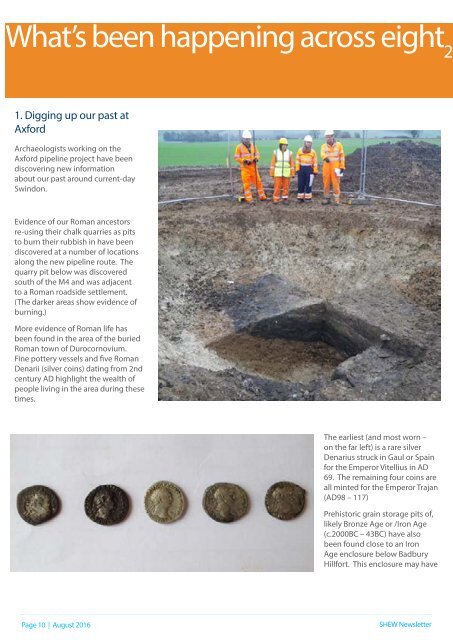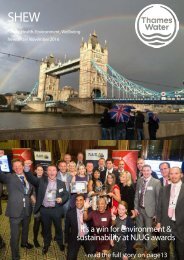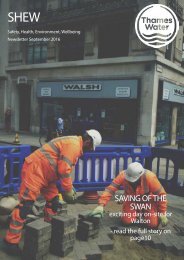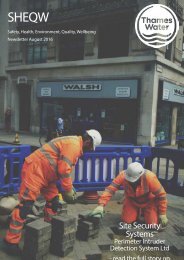SHEQWs Newsletter November
You also want an ePaper? Increase the reach of your titles
YUMPU automatically turns print PDFs into web optimized ePapers that Google loves.
What’s been happening across eight 2<br />
O<br />
1. Digging up our past at<br />
Axford<br />
Archaeologists working on the<br />
Axford pipeline project have been<br />
discovering new information<br />
about our past around current-day<br />
Swindon.<br />
Evidence of our Roman ancestors<br />
re-using their chalk quarries as pits<br />
to burn their rubbish in have been<br />
discovered at a number of locations<br />
along the new pipeline route. The<br />
quarry pit below was discovered<br />
south of the M4 and was adjacent<br />
to a Roman roadside settlement.<br />
(The darker areas show evidence of<br />
burning.)<br />
More evidence of Roman life has<br />
been found in the area of the buried<br />
Roman town of Durocornovium.<br />
Fine pottery vessels and five Roman<br />
Denarii (silver coins) dating from 2nd<br />
century AD highlight the wealth of<br />
people living in the area during these<br />
times.<br />
2. Sharing knowledge<br />
between Utilities<br />
A fantastic demonstration of best<br />
practice sharing and collaboration<br />
between contracts, eight2O, tRIIO<br />
(joint venture for National Grid) and<br />
SQS (a tRIIO recycled aggregates<br />
supplier), occured this month.<br />
Members of the construction, design<br />
and procurement teams from both<br />
SMBJV and CABVJV attended a<br />
recent event to showcase recycled<br />
aggregates; increasing awareness of<br />
the production techniques, technical<br />
applications and ways to ensure a<br />
final quality product.<br />
Chris Stones, from SQS, talked<br />
through the process from when the<br />
waste aggregate is received at the<br />
site through to sorting, screening<br />
and finally production of the recycled<br />
aggregates, including Type 1, pea<br />
shingle and eco surround.<br />
The SQS team also demonstrated<br />
how recycled aggregates are used<br />
for reinstatement across all of<br />
their tRIIO contracts. Backfilling a<br />
specially prepared excavation they<br />
demonstrated how the material is<br />
tampered down and compacted<br />
and how this compaction is tested<br />
aggregates on their contract.<br />
Mark Guinn, Strata Highways,<br />
detailed the testing that is carried<br />
out on the recycled aggregates<br />
produced at SQS and on the<br />
stability and compaction of<br />
the material once it has been<br />
placed in the ground. Mark<br />
also explained the possible cost<br />
savings available if recycled<br />
aggregates are used.<br />
The day provided great learnings<br />
and experience that can be used<br />
on eight2O to increase the usage<br />
of recycled aggregates across our<br />
contracts.<br />
The earliest (and most worn –<br />
on the far left) is a rare silver<br />
Denarius struck in Gaul or Spain<br />
for the Emperor Vitellius in AD<br />
69. The remaining four coins are<br />
all minted for the Emperor Trajan<br />
(AD98 – 117)<br />
Prehistoric grain storage pits of,<br />
likely Bronze Age or /Iron Age<br />
(c.2000BC – 43BC) have also<br />
been found close to an Iron<br />
Age enclosure below Badbury<br />
Hillfort. This enclosure may have<br />
Page 10 | August 2016 SHEW <strong>Newsletter</strong><br />
SHEW <strong>Newsletter</strong><br />
August 2016 | Page 11
















